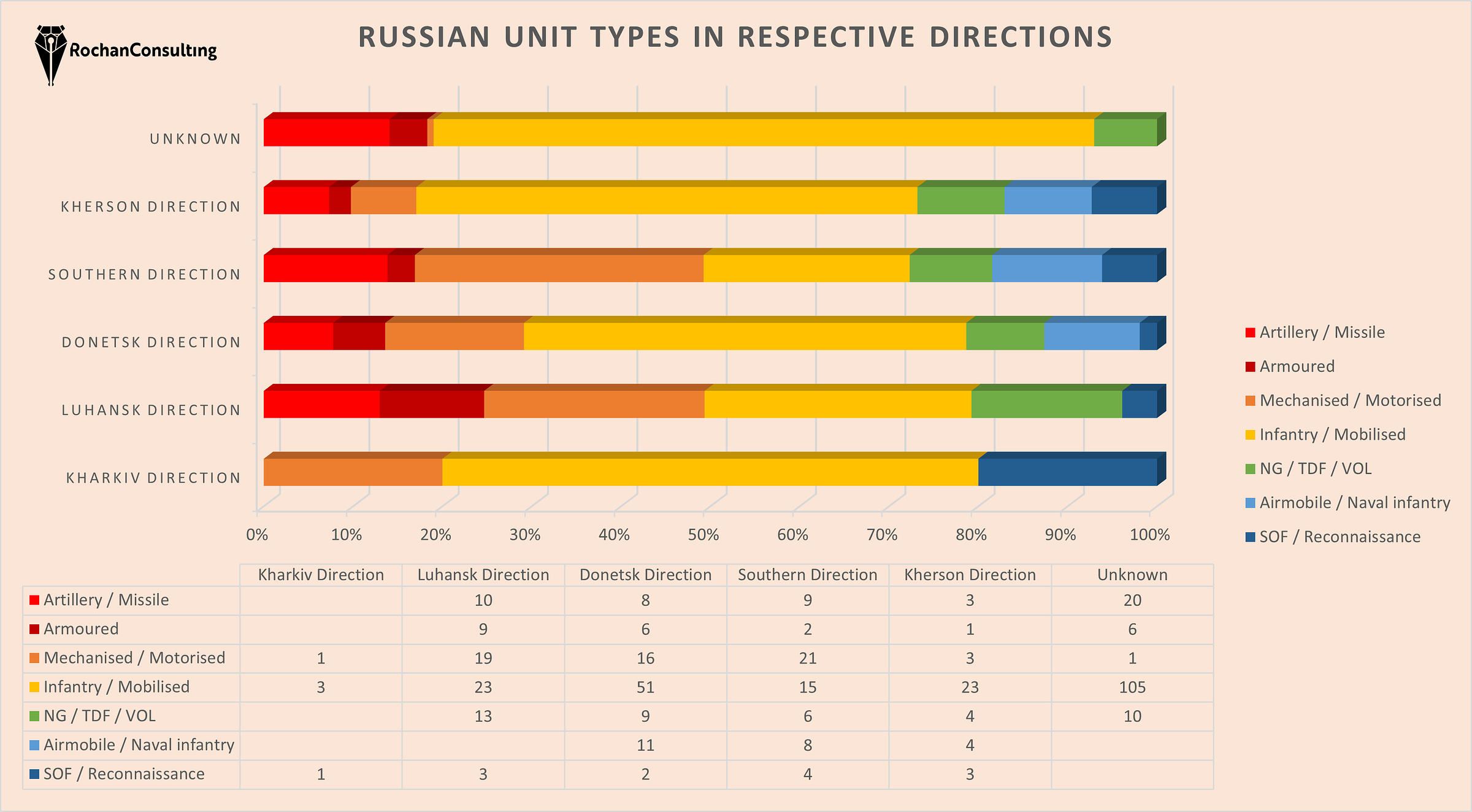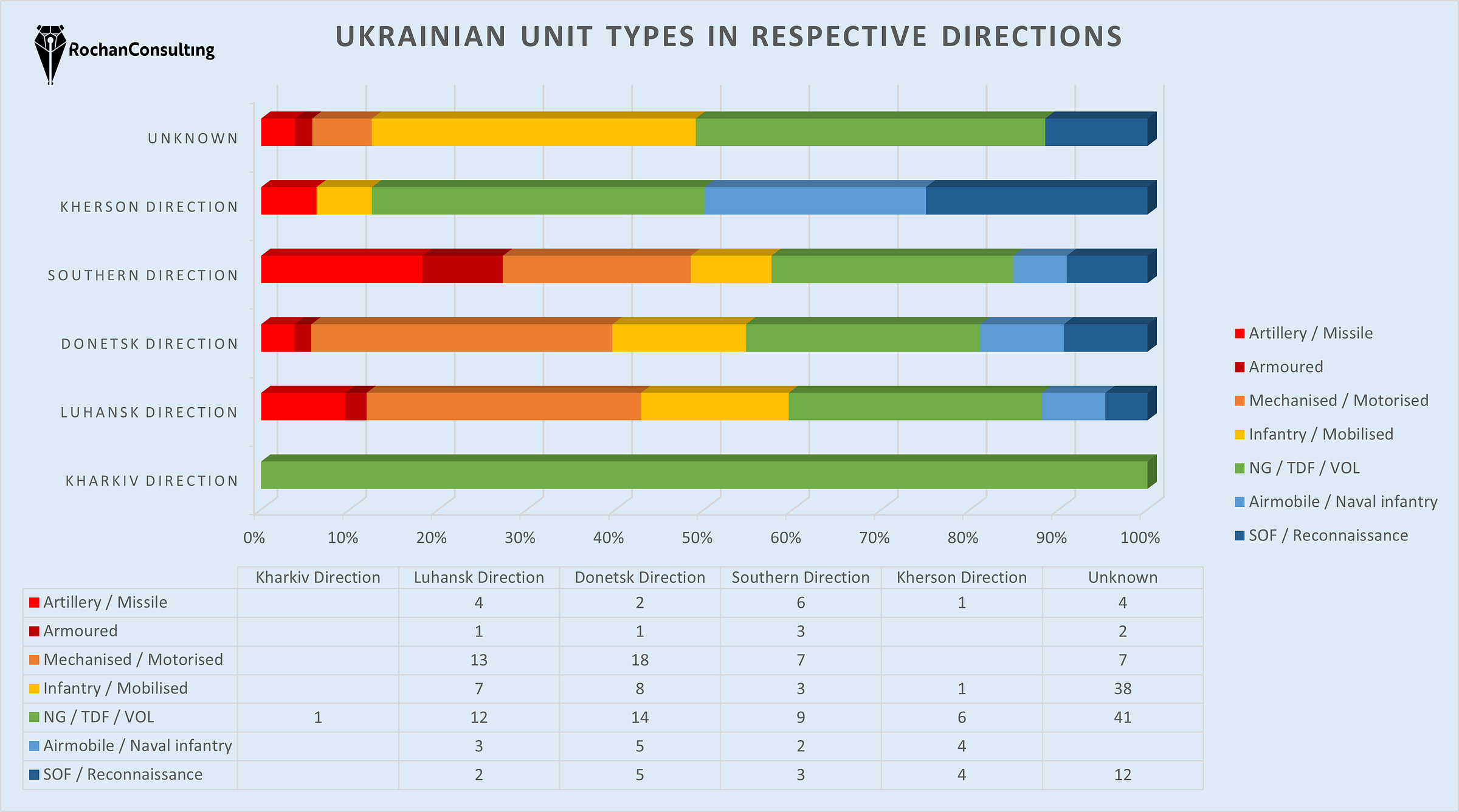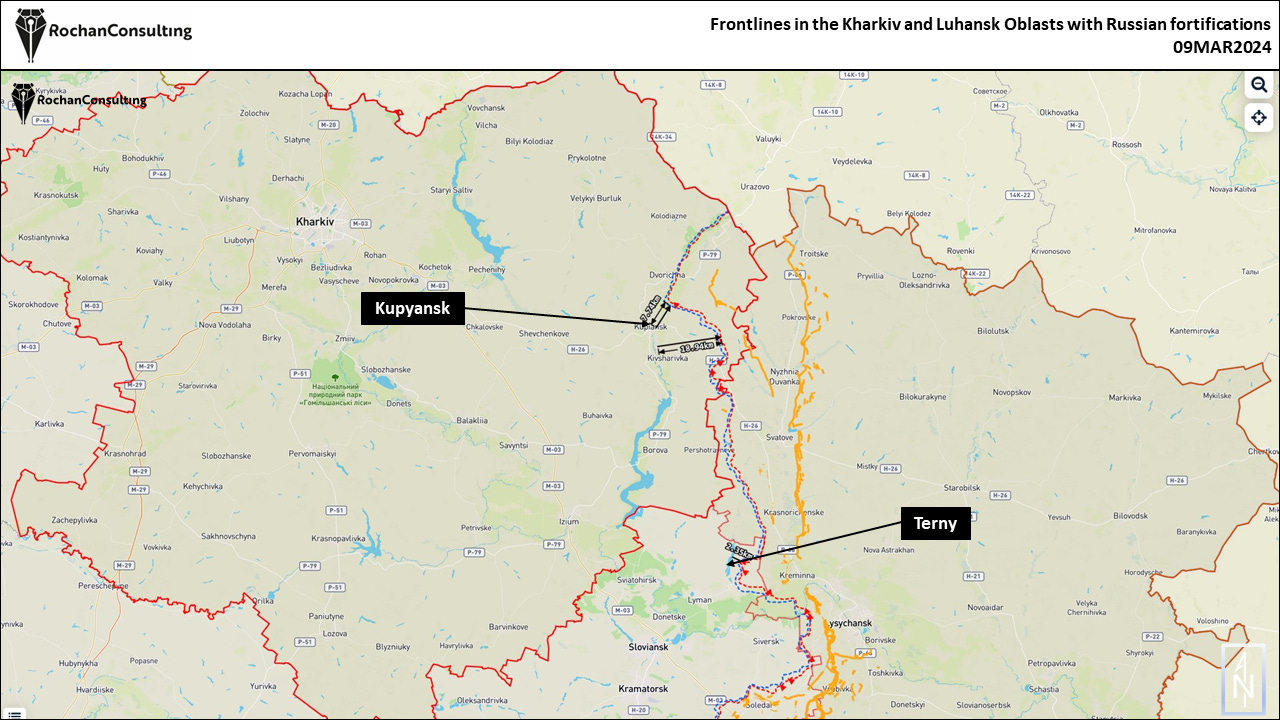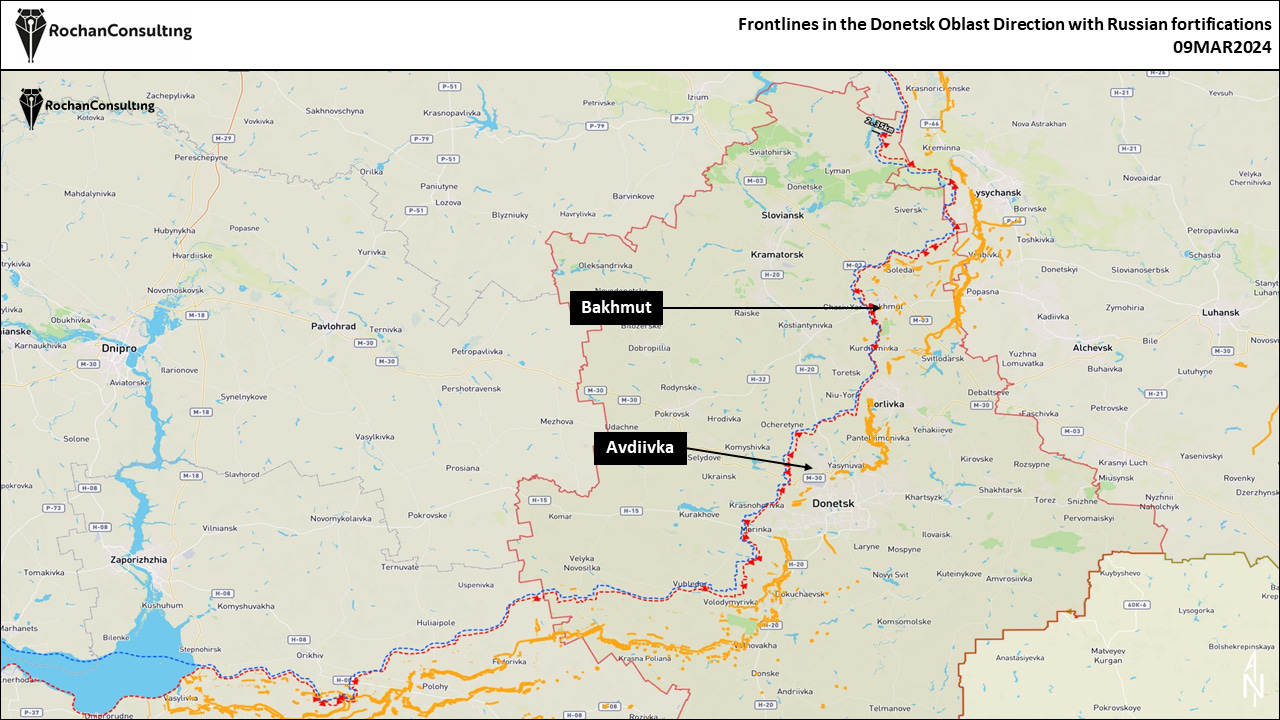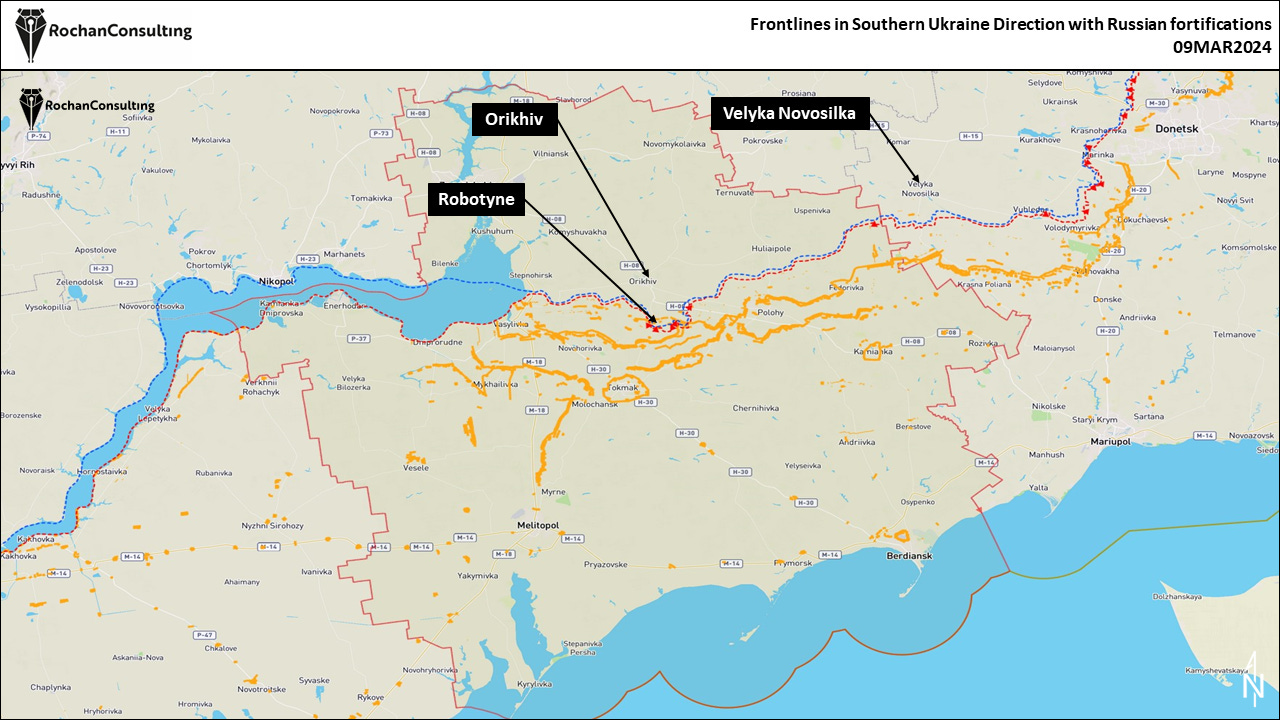Key takeaways from last week’s developments:
The overall situation did not change over the past week; Russian forces remained on the offence, especially in the Donetsk Oblast, where they captured some ground west of Avdiivka; Ukrainians conducted localised counterattacks, expanding reserves; However, without a larger influx of personnel, such an approach is not sustainable;
Russian strike campaign against civilian targets in the Kharkiv Oblast continued;
In the Luhansk Direction, Russians continued to attack Ukrainian positions in the Kupyansk and Lyman axes; They reportedly progressed in both areas, but the overall impact on the operational situation in the region was minimal; Ukrainian source claimed that the number of Russian troops deployed in this direction had not changed for months, which probably indicates a lack of intent to conduct a large-scale offensive;
Russian units remained offensively committed in the Bakhmut and Donetsk axes and progressed in both areas; Ukrainian units were focused on conducting manoeuver defence, delaying actions and establishing fortifications in the rear;
Russians sustained attacks on Robotyne and reportedly entered the village;
Despite Russian MoD claims, Ukrainians maintained their presence near Krynky on Dnipro’s left bank;
Russians launched no mass missile strikes last week, but the use of Shahed kamikaze drones intensified significantly;
Executive summary
According to the Ukrainian General Staff (UGS), during the past seven days, in the Kupyansk axis, the Ukrainian Armed Forces (UAF) repelled 28 Russian attacks (43 two weeks ago) near Synkivka, east of Petropavlivka in the Kharkiv Oblast and Stel’makhivka in the Luhansk Oblast. In the Lyman axis, the UAF repelled 49 Russian attacks (53 two weeks ago) near Makiivka and Serebryansky forest in the Luhansk Oblast and east of Terny in the Donetsk Oblast. In the Bakhmut, Avdiivka, Mariinka and Shakhtarske axes, the Ukrainian soldiers repelled 337 Russian ground attacks (434 two weeks ago) near Bohdanivka, Klishchiivka, Andriivka, east of Novobakhmutivka, Stepove, Avdiivka, south of Tonen’ke, Nevel’s’ke, Pervomais’ke and Novomykhailivka in the Donetsk Oblast. In the Zaporizhzhia axis, the Ukrainian units repelled 31 Russian attacks (36 two weeks ago) near Verbove, Novopokrovka and Robotyne in the Zaporizhzhia Oblast.
According to the UGS, during the past seven days, the Ukrainian Air Force launched air strikes on 52 Russian concentration areas. The Ukrainian missile forces hit six Russian concentration areas, two command posts, two ammunition depots, 11 artillery systems, three air defence systems, one electronic warfare station and one petroleum, oils and lubricants depot.
Over the past seven days, we assess that Ukrainians were not confirmed to have liberated any terrain, while Russians captured around 50 square kilometres. The bulk of this area, around 44 square kilometres, came from gains made west of Avdiivka. The Ukrainian posture remained defensive, which is confirmed by marginal territorial gains, which continue to decrease by the week.
Russian forces sustained offensive operations in the Kupyansk, Lyman, Orikhiv, Bakhmut and Donetsk axes. Attacks in the first three probably have an auxiliary character, as the main Russian focus is on areas west of Bakhmut and Avdiivka. If the reader scrolls down to the summary of events from the Donetsk Direction, one will see that the intensity of Russian attacks in the region was very high, coupled with assertions of further advances.
Another important item coming from these reports is that Ukrainians “defend forward”. Not only do they attempt to wear Russians down during their attacks, but Ukrainians throw reserves in for counterattacks. Russians utilised the same approach in the Orikhiv axis during the Ukrainian counteroffensive. However, its successful implementation necessitates a steady deployment of operational reserves to maintain pressure on opposing forces. Thanks to successful recruitment in 2023, Moscow could defend forward for several months. With its manpower and ammunition shortages, Ukraine is in no position to sustain such an approach over a similar period of time.
One way of mitigating this problem is to shift personnel from support units to frontline formations, but such a solution will only deliver short-term results. It does appear that Ukraine currently lacks a long-term solution to some of its problems, which is especially problematic given the increasing Russian preponderance of fire and manpower advantage.
There is an audit currently taking place within the Ukrainian Armed Forces. Some of its results were already commented on by the Commander-in-Chief of the Ukrainian Armed Forces, Colonel General Oleksandr Syrsky. In early March, he stated that “it became completely clear why, in the case of the same staffing, weapons and military equipment, some brigades manage to hold back enemy attacks and hold their positions, while others do not”. His representatives were subsequently sent to some underperforming brigades to assess their problems further. Ukrainian media suggested that one such brigade was the 110th Mechanised Brigade, which was defending the Avdiivka sector since the start of the full-scale invasion. Syrsky’s comments came after the withdrawal from the city, which indicates that the fall of Avdiivka was attributed to the underperformance of the 110th Mechanised Brigade, especially given that he praised other brigades deployed in the region: the 54th and 47th Mechanised, 79th Air Assault, 25th Airborne Brigades.
What we think Syrsky will bring to the table regarding overall command and control is a desire to exert far-reaching control over brigade and battalion commanders’ decisions and an expectation that his orders will be fulfilled to the letter.
Noteworthy events pertaining to the war
Saturday (02MAR)
French President Emmanuel Macron stressed that the possibility of deploying Western troops to Ukraine “should not be ruled out”.
Sunday (03MAR)
Turkish Foreign Minister Hakan Fidan said that both Russia and Ukraine had reached their limits in terms of war and should “start a dialogue” about a ceasefire.
Monday (04MAR)
Ukrainian President Volodymyr Zelensky claimed that the situation at the Polish-Ukrainian border went “beyond economics and morality long ago”.
Former Russian President Dmitry Medvedev described Ukrainian lands as “parts of Russia” that “need to return home”. He also independently informed that peace talks with the Ukrainian leadership were impossible.
Ukrainian Prime Minister Denys Shmyhal informed that his state would need USD 37 billion in financial aid from its partners in 2024.
The United States Department of Justice informed that a US Strategic Command civilian employee was arrested for disclosing classified data about the course of the Russo-Ukrainian conflict on the dating site.
Tuesday (05MAR)
White House National Security Communications Advisor John Kirby confirmed that American soldiers would not be sent to Ukraine.
Ukrainian Deputy Minister for Strategic Industries, Anna Gvozdyar, informed that drone production in Ukraine may reach two million units in 2024.
The Ukrainian Ministry of Defence announced the purchase of 20,000 UAVs. This refers to 15,000 DJI Mavic 3Es and 5,000 DJI Mavic 3 Thermals, which will be delivered by 31MAY.
The International Criminal Court issued a warrant arrest for the Commander of the Russian Long-Range Aviation, Lt. Gen. Sergey Kobylash, and the former Commander of the Black Sea Fleet, Adm. Viktor Sokolov.
French President Emmanuel Macron met with his Czech counterpart, Petr Pavel, to discuss the provision of ammunition for the Ukrainian Armed Forces.
United Kingdom Foreign Secretary David Cameron claimed that his state was “prepared to loan Ukraine all frozen Russian central bank assets”.
The Ukrainian SBU detained a citizen who joined the Ukrainian Army in 2023 to provide intelligence data for the Russian Armed Forces.
German Minister of Defence Boris Pistorius claimed that the leaked conversation of German Armed Forces representatives (about the potential delivery of Taurus missiles for Ukraine) resulted from an “individual error”.
Wednesday (06MAR)
Ukrainian Ground Forces Commander, Gen. Col. Oleksandr Pavliuk, informed that Ukraine aimed to “stabilise the frontline situation shortly and conduct another counteroffensive in 2024”.
Director of the International Atomic Energy Agency, Rafael Grossi, met with Russian President Vladimir Putin to discuss the safety of the Zaporizhzhia Nuclear Power Plant.
Russian President Vladimir Putin also met with the Governor of Gagauzia (an autonomous part of Moldova), Evghenia Guțul. He promised to “extend support to Gagauzia and its citizens in upholding their legal rights, authority and positions in the international arena”.
Bloomberg informed that the United States was considering allocating USD200 million from the US Army funding to support the Ukrainian Armed Forces with an additional aid package.
The Russian court in Rostov-on-Don sentenced the Ukrainian defender of Mariupol to 20 years in a strict regime colony.
Thursday (07MAR)
Ukrainian President Volodymyr Zelensky signed a decree regulating the transfer to the military reserve of servicemen whose terms of service had expired during martial law.
Ukrainian President Volodymyr Zelensky also appointed the former Commander-in-Chief Gen. Valerii Zaluzhnyi as the next Ukrainian Ambassador to the United Kingdom.
Chinese Foreign Minister Wang Yi claimed that China considers itself a “force for peace”, even if it pursues deeper ties with Russia.
Sweden joined NATO.
The Lithuanian intelligence provided its annual threat assessment, according to which the Russian Armed Forces will be able to continue their war efforts at a similar intensity level for about two years.
Lithuanian Minister of Defence Arvydas Anušauskas announced the transfer of an additional 155-millimetre artillery shells to Ukraine.
United Kingdom Minister of Defence Grant Shapps said his state would allocate USD416 million to purchase over 10,000 new UAVs for the Ukrainian Armed Forces.
Friday (08MAR)
French Minister of Defence Sebastien Lecornu claimed that France had no plans to deploy its “combat troops” to Ukraine. However, he also noted that the deployment of personnel to participate in mine-clearing activities or training could not be completely ruled out.
Luxembourg Defence Minister Yuriko Backes said that her state had recently provided Ukraine with 6,000 155-millimetre artillery shells.
Ukraine battle map
Please click here to access our interactive map and click here to access the archive.
The situation at selected axes and directions
Below, the reader will find information about Russian and Ukrainian units deployed in respective directions. We attach medium confidence to this data. The list is not exhaustive, either. However, the reader should know that we change/update Russian and Ukrainian ORBATs daily. Secondly, the unknown column shows the number of units whose current whereabouts are unclear. There are a lot of units uncommitted on both sides.
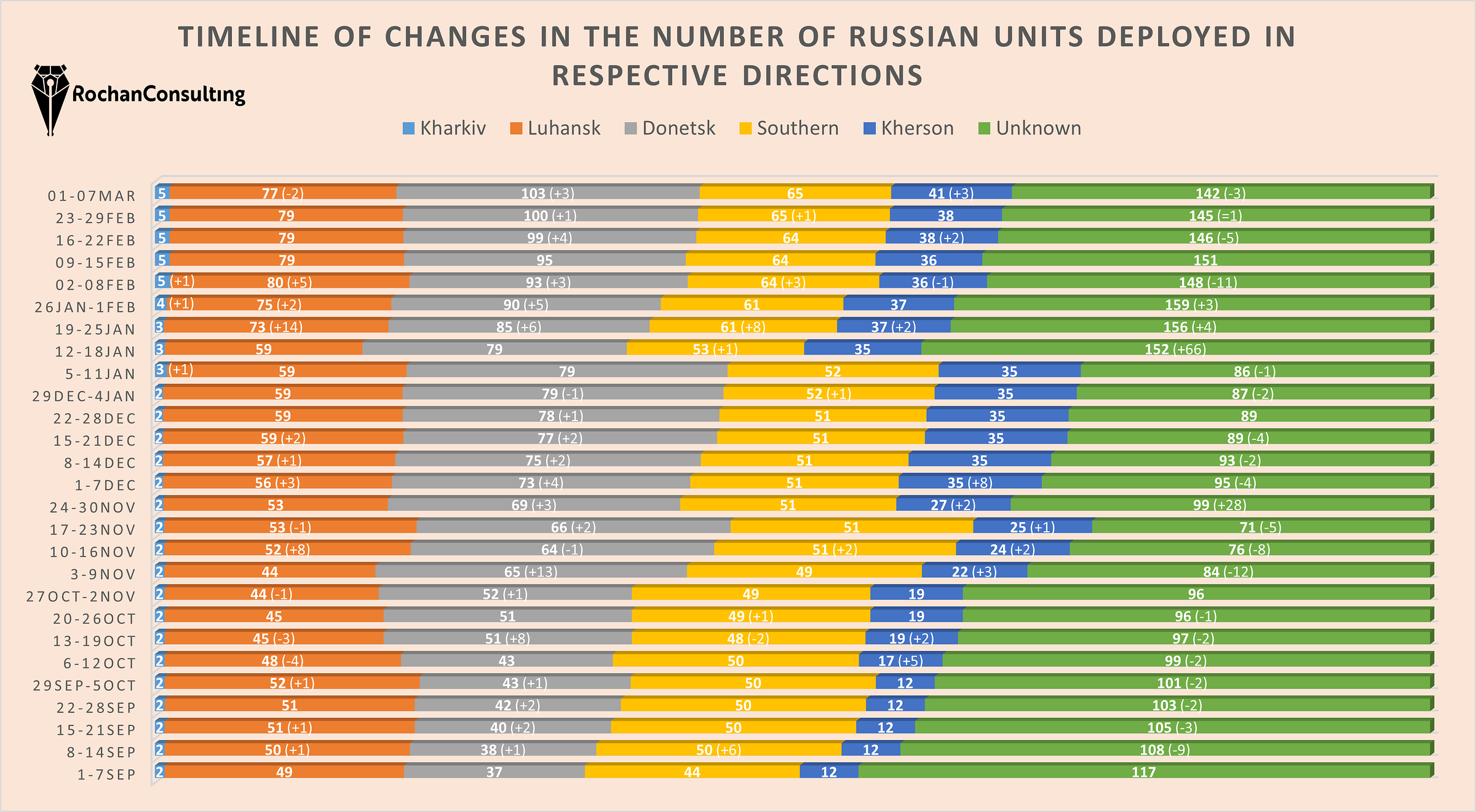
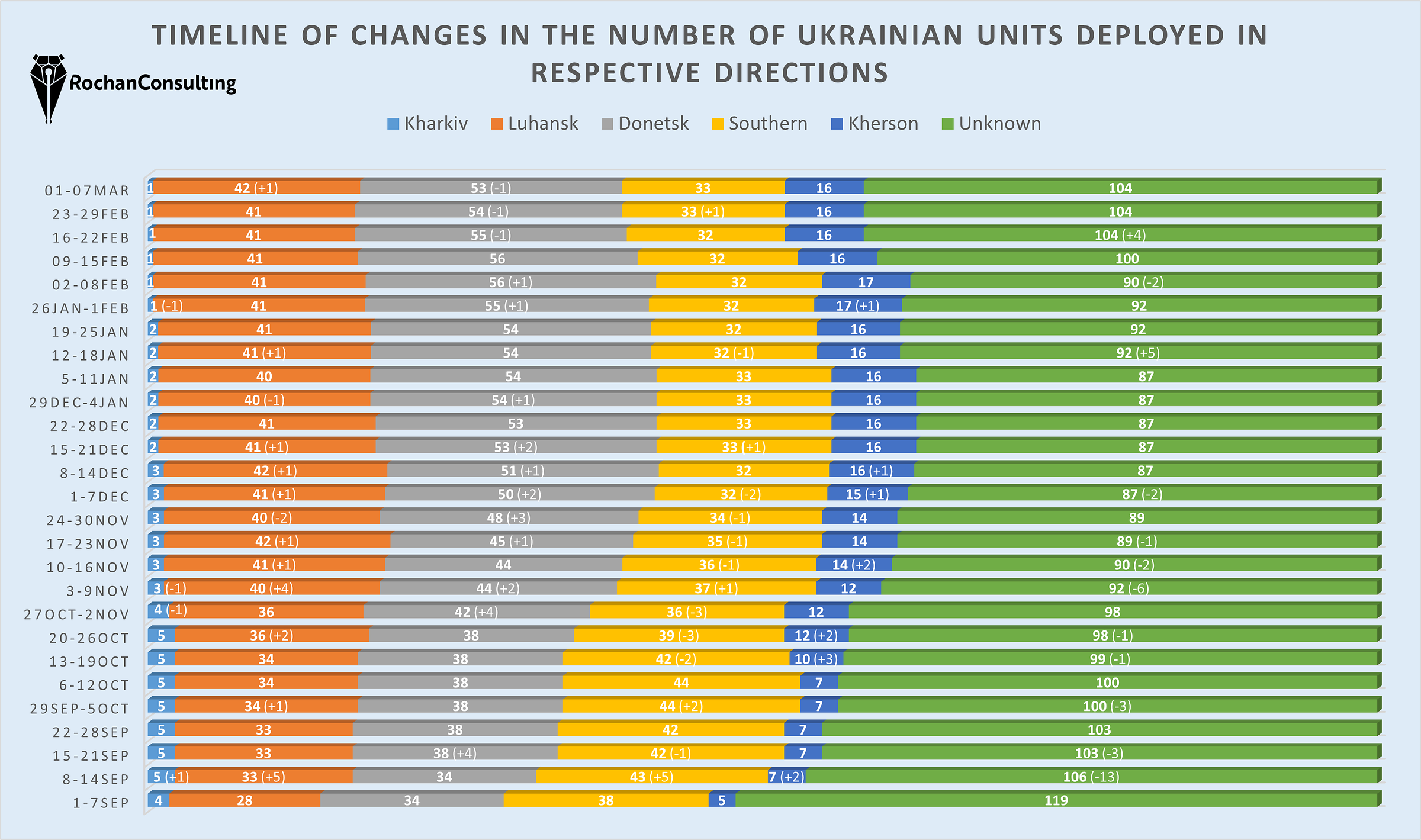
Last week, we noted no significant Ukrainian redeployments.
However, available data indicated the presence of the 3rd Special Purpose Regiment’s elements (SOF) in the Makiivka area. The unit was previously stationed in the Horlivka axis (Donetsk direction).
Furthermore, following the capture of Avdiivka and additional Russian gains west of the city, we modified units deployed in the Donetsk and Horlivka axes. Namely, all Ukrainian formations and units deployed south of Ocheretyne were transferred to the Donetsk axis, which aligns them with Russian units deployed on this axis.
The Russian Armed Forces remained focused on the Donetsk axis within the Donetsk direction.
The observed Russian activity suggested a persistent commitment to strengthening forces in the Donetsk direction.
In the Avdiivka area, we documented the arrival of the mobilised 348th Motor Rifle Regiment (possibly operationally subordinated to the 90th Tank Division) and elements of the 24th Spetsnaz Brigade (Central Military District).
Further south, but also in the Donetsk axis, reported skirmishes confirmed the presence of the recently formed 242nd Motor Rifle Regiment (20th Motor Rifle Division, 8th CAA).
We also placed the 1196th, 1197th, and 1999th Motor Rifle Regiments, operationally subordinated to the 49th Combined Arms Army, in the Kherson direction.
Kharkiv Oblast Direction
No significant changes occurred in the Kharkiv Oblast.
According to Oleh Synehubov, the head of the Kharkiv Oblast administration, Russians continued to shell civilian infrastructure in the Kharkivsky, Bohodukhivsky, Kupyansky, Izuimsky and Chuhuivsky districts. In particular, Russians hit Dvorichna, Berestove, Vovchansk, Oleksandrivka, Okhrimivka, Vilkhuvatka, Khatnje, Topoli, Kozacha Lopan, Synkivka and Ivanivka, Petropavlivka, Vovchanski Khutory and Kupyansk.
On Saturday (02MAR), the Russians struck Kharkiv with Shahed-136s. Synehubov claimed that civil infrastructure was damaged. No injuries or deaths were reported.
Luhansk Oblast Direction
No significant changes occurred in the Luhansk Oblast. The Russians continued attacking Ukrainian positions in the Kupyansk – Lyman direction, but no frontline changes were recorded.
On Saturday (02MAR), the Russian source claimed that the Ukrainian forces had recaptured several positions near Tabaivka. They were trying to regain control of a section of the P-07 road, information which was somewhat confirmed by Ukrainian bloggers on Sunday (03MAR). They also said the UAF continued repelling Russian attacks near Synkivka. However, another Russian source stated that Russian units advanced 200 metres on the settlement’s northern outskirts, weakening the UAF posture in the area. On Monday (04MAR), the Russian source claimed that the heavy meeting engagements continued near Synkivka and Tabaivka, but no changes were recorded. The Ukrainian sources did not report changes in this area. On Tuesday (05MAR), the Russian journalist claimed that the heavy meeting engagements continued near Tabaivka. The source said the Russian forces abandoned some previously occupied positions, but no detailed information was provided. The Ukrainian sources did not report changes in this area. On Wednesday (06MAR), geolocated footage was published, indicating that Russians advanced on the northern outskirts of Synkivka. On the other hand, a Ukrainian source claimed on Thursday (07MAR) that the UAF continued to hold Synkivka, repelling Russian attacks. The Russian sources did not report changes in the area.
On Saturday (02MAR), Ilya Yevlash, Ukrainian Khortytsia (Eastern) Group of Forces Spokesperson, claimed that in the Kupyansk sector, the Russians slightly reduced the intensity of the attacks near Synkivka. Yevlash also added that the Russians were regrouping in the Lyman sector and preparing assault groups.
On Tuesday (05MAR), Oleh Synehubov assessed that in the Lyman-Kupyansk sector, the Russians had more than 100,000 troops (40% of this number are assault troops), adding that this figure had been unchanged for months. Synehubov further added that the UAF was also building fortifications near Belgorod Oblast in the Sumy, Vovchansk and Lyman-Kupyansk directions.
On Wednesday (06MAR), Lieutenant General Oleksandr Pavliuk, Commander of Ukraine’s Ground Forces, stated that Ukraine was stabilising the contact line and would begin preparing for counteroffensive actions to seize the initiative. Pavliuk described the situation on the battlefield as complicated but controlled. He noted that judging by the number of soldiers estimated to have been killed and captured, Russians were throwing newly mobilised servicemen at the contact line without any training. He mentioned that Russian troops were focusing their offensive actions mainly on Avdiivka and Chasiv Yar and in the direction of Lyman. He also noted that they were striving to uphold a consistent pace of offensive manoeuvres along the entire frontline.
No changes occurred near Dvorichna. Neither Russian nor Ukrainian sources reported changes/attacks.
No changes occurred near Petropavlivka, Krohmalne and Ivanivka. Neither Russian nor Ukrainian sources reported changes.
No changes occurred near Svatove. Neither Russian nor Ukrainian sources reported changes during the week.
No changes occurred near Novoselivske. Neither Russian nor Ukrainian sources reported changes.
No changes occurred near Stelmakhivka. Neither Russian nor Ukrainian sources reported changes.
No changes occurred near Novovodyane. Neither Russian nor Ukrainian sources reported changes.
No changes occurred near Raihorodka. Neither Russian nor Ukrainian sources reported changes/attacks.
On Sunday (03MAR), the Russian source claimed that the Russian forces had advanced near Yampolivka and Terny, pushing the UAF closer to the Zherebets River. The Ukrainian source said that on Saturday (02MAR), Ukrainian soldiers of the 60th Separate Mechanised Brigade repelled a “massive” Russian attack near Yampolivka. The Russian assault was carried out in three waves, with seven units of equipment participating in the first wave, and then other forces were brought up as reinforcements during the day. The assault was successfully repelled, with Russian forces suffering numerous losses, according to Ukrainian sources. Despite this, the Russian focus on the Terny-Yampolivka-Dibrova-Bilohorivka section was firm. Russians used vehicles, infantry, artillery, and frontal aviation to advance forward. On Tuesday (05MAR), the Russian journalist claimed that Russian continued assault operations led them to capture Ukrainian strongholds near Yampolivka and Terny. On Wednesday (06MAR), the Russian journalist assessed that Russian troops continued to attack near Terny and Yampolivka, but no changes were recorded.
All the abovementioned Russian changes were not independently verified.
No changes occurred near Makiivka, Ploshchanka and Chervonopopivka. Neither Russian nor Ukrainian sources reported changes/attacks. Also, no changes occurred near Torske and Nevske.
In the Kreminna area, no significant changes occurred. Positional battles continued in the Serebryasnky foresty and near Dibrova. Neither Russian nor Ukrainian sources reported changes.
In Bilohorivka, positional battles continued near the settlement. Neither Russian nor Ukrainian sources reported significant changes.
According to Sergey Zybinskyi, a Russian Western Group of Forces Spokesperson, during combat actions in the Kupyansk axis, Russian units repelled 14 Ukrainian attacks near Synkivka, Tabaivka and Terny.
According to Leonid Sharov, a Russian Centre Group of Forces Spokesperson, in Lyman’s direction, Russian units of the Centre Group of Forces, supported by air and artillery fire, repelled 12 Ukrainian attacks near Terny, Yampolivka, Berdychi, Tonenke, Pervomaiske, Orlivka and Vodyane.
(The data on Russian fortifications comes from Black Bird Group/DefMon)
Donetsk Oblast Direction
Over the past week, the Russians continued attacks near the Bakhmut, Avdiivka and Novopavlivka axes. They continued to build on their success near Ivanivske, Berdychi, Orlivka, Tonenke and Novomykhailivka, where they made minor territorial gains.
No changes occurred near Spirne, Ivano-Darivka, Vyimka and Verkhnokamyanske. The same goes for Rozdolivka and Vasiukivka. Neither Russian nor Ukrainian sources reported changes.
Over the past week, the Russians continued to attack near Ivanivkse and Bohdanivka. Ukrainian sources stated that Russian troops were exerting heavy pressure at Ivanivske to break through to Chasiv Yar. Ukrainian soldiers stated that there was almost no place to gain a foothold, as the village was practically destroyed. On Sunday (03MAR), geolocated footage confirmed a Russian advance in the village’s centre. Later, a Ukrainian soldier said the Russians also managed to advance in the north. In Bogdanivka, Ukrainians were able to push the Russian troops slightly back. On Tuesday (05MAR), the Ukrainian source said that Ukrainian troops advanced on one of the positions near Bohdanivka, but no visual evidence was provided to confirm this development. Due to the severe pressure of Russian troops on Ivanivske, Ukrainian troops could be forced to withdraw from the village to prepare for the defence of Chasiv Yar. Also, after capturing Ivanivske, some Russian troops can potentially switch to Klishchiivka for additional pressure to capture the heights near the settlement for further artillery shelling of Chasiv Yar.
In Bakhmut, no changes occurred. Neither Russian nor Ukrainian sources reported changes.
On Sunday (03MAR), the Ukrainian blogger stated that the Russians became more active north of Klishchiivka. The Russian source also assessed that on Sunday, Russian units tried to attack Ukrainian positions from the southeast and on the heights northwest of the Klishchiivka. They also attempted to break through the Ukrainian defence near Andriivka but were unsuccessful. On Monday (04MAR), the Russian source said that Russian troops continued to attack near Klishchiivka, but no changes were recorded. On Wednesday (06MAR), the Russian journalist claimed that Russian troops managed to advance near the village, but this information remained unconfirmed.
On the other hand, a Ukrainian soldier stated that on Wednesday (06MAR), the Russians indeed tried to break through Ukrainian defences in the north of Klishchiyivka but were unsuccessful. Two armoured personnel carriers were destroyed. Several were hit but managed to retreat to Bakhmut.
No changes occurred near Kurdyumivka. Neither Russian nor Ukrainian sources reported changes.
On Tuesday (05MAR), the Russian source posted footage (later geolocated) showing a successful missile strike on Ukrainian HIMARS MLRS near Nykanorivka in the Donetsk Oblast. This is the first confirmed HIMARS loss since Ukraine received the system in June 2022.
On Sunday (03MAR), the Ukrainian bloggers claimed that the Russians tried to advance in Berdychi but were unsuccessful. The Russians also continued accumulating manpower in Orlivka to increase pressure and capture the rest of the village. The source stressed that as of Sunday (3MAR), the Russian units did not entirely control the village. However, between Tonenke and Orlivka, the Russians slightly improved their tactical position. On the other hand, on Sunday (03MAR), Dmytro Lykhovyi, Ukrainian Tavria (Zaporizhzhia and Kherson Oblasts) Group of Forces Spokesperson, claimed that the operational situation stabilised near Berdychi, Orlivka and Tonenke. However, the contact line was quite dynamic, as Russian forces sometimes had localised successes in some positions but without significant advances. On Tuesday (05MAR), the Russian source claimed that a third Abrams tank was destroyed near Berdychi. The source said that Ukrainians maintain a manoeuvre defence but come under fire from Russian artillery when they attempt to counterattack with armoured groups.
On Wednesday (06MAR), the Russian source stated that Russians control half of the Tonenke. In Orlivka, most of the village was also under Russian control. The source added that Ukrainians continued to spend reserves to hold their positions. However, a Ukrainian soldier claimed that as of Wednesday (06MAR), the Russians controlled about 75 per cent of Tonenke. On the other hand, the Ukrainian Tavriisk Group of Forces Press Service stated on Wednesday (06MAR) that Ukrainian troops had erected a supplementary line of defensive structures in the Avdiivka axis. These structures include asphalt-supported platforms to enhance the height and stability of trench walls, anti-tank ditches, concrete bunkers, dragon teeth, and various other fortified installations.
On Tuesday (05MAR), Dmytro Lykhovyi said that the fortifications of the Ukrainian forces in the Donetsk region do not look like a continuous line and differ from the defences of Russian positions. Fortifications were tied to the terrain and features of the area, as well as the presence of rivers and lakes. He added that work was continuing to construct fortifications in various areas. Ukrainian defenders have prepared tank ditches, bunkers and “armoured capsules”.
On Tuesday (05MAR), the Russian source claimed that Russians faced a total lack of interaction between FPV groups and EW units near Berdychi. As for the situation in the Avdiivka axis, approximately 30 per cent of the FPV drones reached the target. The rest falls right behind Lastochkyne or even at take-off due to Russian EW suppression. The source stated that there had long been questions about establishing a UAV and EW Coordination Centre, at least at an army level. However, no concrete steps were taken to achieve this objective.
On Sunday (03MAR), the Ukrainian blogger claimed that Russian units continued to attack Ukrainian positions near Pervomaiske. On Wednesday (06MAR), the Russian journalist stated that the heavy battles continued near Nevelske and Pervomaiske. Another Russian source claimed that Russians control about 50 per cent of Pervomatikse. The Ukrainian sources did not report changes.
On Sunday (03MAR), the Ukrainian blogger stated that the Russians continued their offensive near Novomykhailivka, Krasnohorivka, south and west of Pobjeda, and near Heorhiivka. The source said that the Russian attempts to enter Krasnohorivka were unsuccessful. However, the Russians managed to gain a foothold in Novomykhailivka. The Russian source also claimed on Monday (04MAR) that the Russian forces control just under half of Novomykhalivka, but battles in the village continued. The source also added that Russian assaults continued near Heorhievka and Krasnohorivka. The battles already occurred on the southern outskirts of the latter. However, the Ukrainians were actively counterattacking at the expense of available reserves, trying to drive Russian assault forces out. On Tuesday (05MAR), the Russian source asserted that despite heavy resistance by the UAF in Krasnohorivka, Russian troops managed to gain a foothold on the southern outskirts of the settlement. The situation was similar in Heorhievka, where the Russian forces advanced into the village. Another Russian source claimed on Tuesday (05MAR) that Russian troops continued their assault on Novomykhailivka from two directions and were also consolidating their positions in the settlement. Advancing from the east, Russian units of the 155th Naval Infantry Brigade of the Pacific Fleet occupied seven more houses in the village. The source added that the situation for the UAF in the village deteriorated, but they had no plans to retreat. The forces of the Ukrainian 79th Air Assault Brigade and other formations were trying to cling to every house and also using FPV drones to attack the supply routes of the Russian units participating in the assault on the village.
Also, ), geolocated footage was published on Tuesday (05MAR), showing Russian forces advanced in the fields south of Novomykhailivka. The Ukrainian sources did not report changes in this area. The source said that the Russian forces managed to advance in Novomikhailivka and already controlled under half of the settlement as of Wednesday. In the southwestern outskirts of Pobieda, the Ukrainians were trying to establish defences, entrenching themselves and mined approaches, carrying out counterattacks, which were more diversionary to allow the infantry to prepare new defensive lines. Also, the Russian troops managed to occupy more favourable positions near Heorhievka, having advanced from the north of the reservoir. Geolocated footage was published on Wednesday, indicating that Russians advanced in the settlement. The Ukrainian sources did not report changes.
According to Vadym Astafiev, a Russian South Group of Forces Spokesperson in the Donetsk Direction, Russian units successfully repelled 14 Ukrainian attacks near Berestove, Klishchiivka, Shumy, Bilohorivka, Heorhiivka, Novomykhailivka and Pobieda.
Southern Ukraine direction
In the Velyka Novosilka axis, no changes occurred. In the Orikhiv axis, the Russians continued to put pressure on Robotyne and Verbove. They achieved some progress, but no significant changes were recorded.
On Saturday (02MAR), Russian sources claimed that Russian troops tried to attack near Zolota Nyva but were unsuccessful. The Ukrainian sources did not report changes/attacks.
On Sunday (03MAR), the Ukrainian source claimed that the Russians tried to attack Ukrainian positions near Novodonetske but were unsuccessful. The Russian sources did not report changes.
Neither Russian nor Ukrainian sources reported changes near Novomaiorske.
On Saturday (02MAR), the Russian source claimed that Russian troops tried to attack near Staromaiorkse but were unsuccessful. The Ukrainian sources did not report changes.
Neither Russian nor Ukrainian sources reported changes near Urozhaine.
Neither Russian nor Ukrainian sources reported changes near Novodarivka.
Neither Russian nor Ukrainian sources reported change near Levadne.
In the Orikhiv axis, on Sunday (03MAR), the Russian source claimed that, with artillery support, Russian forces continued to attack the southern approaches of Robotyne. Some Russian sources asserted that Russian units made their way to the centre of Rabotyne due to the increasing use of FPV drones. On the other hand, a Ukrainian blogger stated that the Russians continued to be active near Robotyne and Verbove, but no changes were recorded on Sunday. The source added that some Russian activity south of Chervone had been recorded. This could be an attempt to test Ukrainian defences in the area or a distraction. However, a Ukrainian soldier described the situation near Robotyne as complicated. The Russians had brought prisoners (Storm-V? units), forcing them to attack positions south of Robotyne. Between Robotyne and Novoprokopivka, the Russians almost don’t use the equipment. On Monday (04MAR), the Russian source stated that the Russian forces continued attacking the southern and southeastern outskirts of Robotyne. The source said artillery was active on both sides, and the settlement remained predominantly in the „grey zone”. Another Russian source said that Russian troops faced problems with attacking Ukrainian positions due to Ukrainian mines. Another Russian source acknowledged on Monday (04MAR) that the Ukrainians had deployed operational reserves and were attempting to stabilise the situation near Robotyne and Verbove. The source said that the Russian forces had not yet been able to establish a foothold in Robotyne, so the focus shifted to positions east and west of the village. On Tuesday (05MAR), the Russian source claimed that the Ukrainian forces were attempting to counterattack near Robotyne to dislodge Russian troops from the previously occupied lines on the southern outskirts of the village. On Wednesday (06MAR), the Russian journalist stated that the UAF were trying to dislodge the Russian soldiers who were entrenched in part of the settlement but were unsuccessful. Russians, in turn, advanced from the south between Rabotyne and Verbove. The Ukrainian blogger also confirmed Russian advances. Also, on Thursday (07MAR), the Dmytro Lykhovyi claimed that Russians increased their offensive in the Orikhiv axis and tried to cut off the Robotyne salient. He said that in the previous days and weeks, Russian attacks fluctuated between 0 to 5. However, over the previous day (06MAR), 16 attacks were recorded near Verbove and Robotyne.
However, another Russian source stated that near Rabotyne, Russians lacked counter-battery fires and EW. The source also added that the UAF had significantly less manpower.
Neither Russian nor Ukrainian sources reported changes near Kamyanske.
Neither Russian nor Ukrainian sources reported changes near Kopani.
Neither Russian nor Ukrainian sources reported changes near Novofedorivka.
Neither Russian nor Ukrainian sources reported changes near Pyatykhatky.
Kherson Direction and Crimea
No significant changes occurred in the Kherson Oblast. Ukrainian forces continue to hold a bridgehead on Dnipro’s left bank despite Russian counterattacks.
On Saturday and Sunday (02-03MAR), positional battles continued near Krynky. Neither Russian nor Ukrainian sources reported significant changes.
The Russian source said on Saturday (02MAR) that Russian commanders in the Krynky area continued to make false reports about the situation on the left bank of the Dnipro River.
On Monday (04MAR), the Russian source claimed that the positional battles continued near Krynky. The source also said that Russian troops continued to destroy Ukrainian groups near Antonovsky Bridge at Dachi. The Ukrainian sources did not report a change in this area.
On Wednesday (06MAR), tensions in the Kherson Oblast seemed to ease, with Ukrainian units refraining from artillery use. However, Ukrainian soldiers apprehended this lull as a prelude to an impending major offensive by Russian forces. Meanwhile, Russian sources claim a shift in focus towards eliminating Ukrainian personnel in Krynky. Ukrainians were reported to be taking refuge in the remains of destroyed buildings, impervious to artillery strikes, while clandestinely constructing underground communication passages. The UAF mobilised reinforcements, moving small infantry groups across the Dnipro River. Additionally, the Ukrainians maintained an aggressive stance, utilising drones and artillery, including cluster munitions, to target Russian assault groups in the village. The UAF also maintained strategic positions on islands within the Dnipro River floodplain, near Dachi at the Antonovsky Bridge, fortified the right bank with engineering structures and barriers to thwart potential Russian landing operations.
On Monday (04MAR), Natalia Humeniuk, the spokesperson for the Ukrainian Command South, claimed that the Russian forces had begun to use X-31P anti-radar missiles more frequently to detect Ukrainian air defence systems. According to her, after losing the A-50 long-range radar reconnaissance aircraft, the Russians became more active using these missiles.
On Tuesday (05MAR), the Ukrainian HUR, with the cooperation of Ukrainian Naval forces, destroyed the Russian Project 22160 patrol ship Sergei Kotov using Magura V5 maritime drones. The Russian ship sustained damage to the stern, starboard and port sides. On Wednesday (06MAR), the HUR also claimed that at least 27 crew members were killed.
Summary of losses
According to the Russian Ministry of Defence, since the start of the war, Ukraine has lost 577 aircraft (+6), 267 helicopters (+1), 14,855 UAVs (+1,463), 484 anti-aircraft missile systems (launchers?)(+11), 15,409 tanks and other armoured combat vehicles (+189), 1,235 MLRS launchers (+10), 8,332 field artillery guns and mortars (+171), as well as 19,549 units of special military vehicles (+494).
According to the Ukrainian General Staff, Russia lost (eliminated) 423,160 personnel (+13,340), 6,712 tanks (+170), 12,823 armoured combat vehicles (+382), 10,428 artillery systems (+447) and 1,012 MLR systems (+13), 707 anti-aircraft systems (+23), 347 aircraft (+7) and 325 helicopters (0), and 8,041 UAVs (+360), 1,919 cruise missiles (+12), 26 warships and boats (+1), submarines 1 (0), 13,638 vehicles and fuel tanks (+672), and 1,666 special vehicles (+88).
(Numbers in parentheses denote a fortnightly change)
Russian strikes and attacks in Ukraine
Over the past two weeks, Russians did not launch a single mass missile strike, although some missiles were fired. Altogether, Russians fired missiles on three occasions (24, 26, 27FEB). These strikes involved 18 missiles, of which seven were intercepted (38%).
The intensive use of Shahed kamikaze drones compensated for decreased missile strikes.
Since 24FEB, Russians have launched ten strikes using these vehicles. The number of Shaheds employed varied from four to 42, with an average of 16 Shaheds used per strike. The Wednesday (06MAR) attack that involved 42 drones was the largest since 11FEB when 45 were employed and the second largest since 1JAN. Another big strike occurred two days later (08MAR) when 37 vehicles were launched. Altogether, between 02-08MAR, Russians launched 118 Shaheds.
Ukrainians claimed to have achieved an average interception rate of Shaheds of around 88% in the past two weeks.
Ground attacks saw no fundamental changes. Russians have maintained a rather steady intensity of these attacks since around 10FEB. Since then, the average has fluctuated between 80 and 90 daily attacks.
Moving onto the air strikes, Russians peaked on 13FEB with 159 attacks, but the 10-day moving average reached its peak a week later when it reached 99 attacks (Sirsky gave the order to pull back from Avdiivka on 17FEB). Since then, Ukraine has noted a decrease in air strikes, with an average of 80 strikes per day as of Friday.
We also observed no significant changes in (battlefield) missile strikes. They continue to be employed in small numbers. Indeed, over the past two weeks, Russians reportedly fired six missiles per day.
Battlefield missile attacks slightly increased. Ukrainians reported 35 attacks over the past week, 92 (two weeks ago), averaging slightly around six per day.
Air strikes continued to fluctuate, but the trend has generally been upward. Last week, Russians averaged 94 attacks per day. But, attacks were sinusoidal. On Sunday (18FEB), Russians launched 43 attacks, but three days later (20FEB), this number almost tripled to 125. The latter half of the week saw a decline to 83 attacks on Thursday.
MLRS strikes continued to increase, and their intensity has been the highest since we started tracking this data in March 2023. Russians averaged 130 strikes daily over the past two weeks, and the trajectory is still upward.
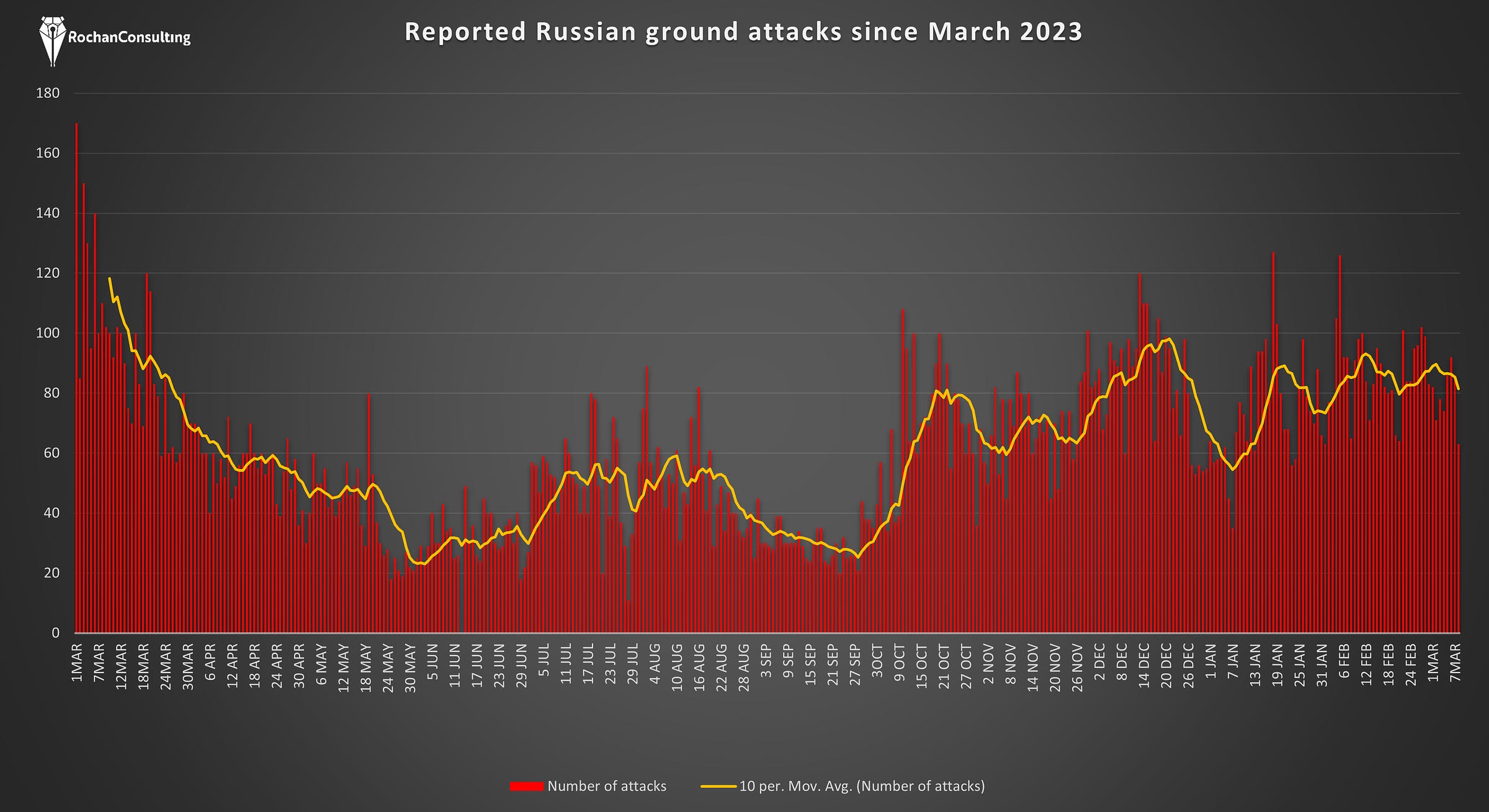
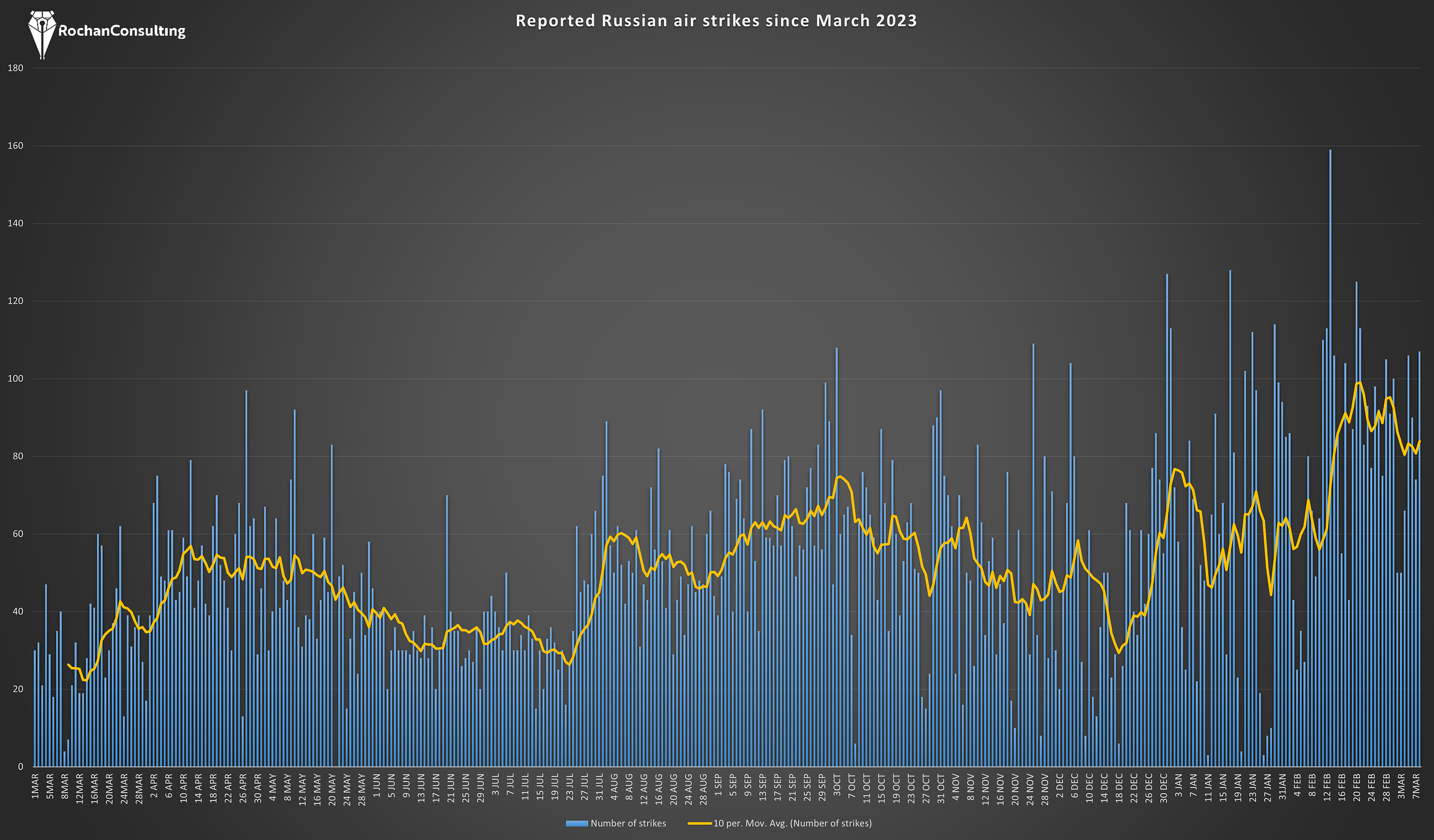
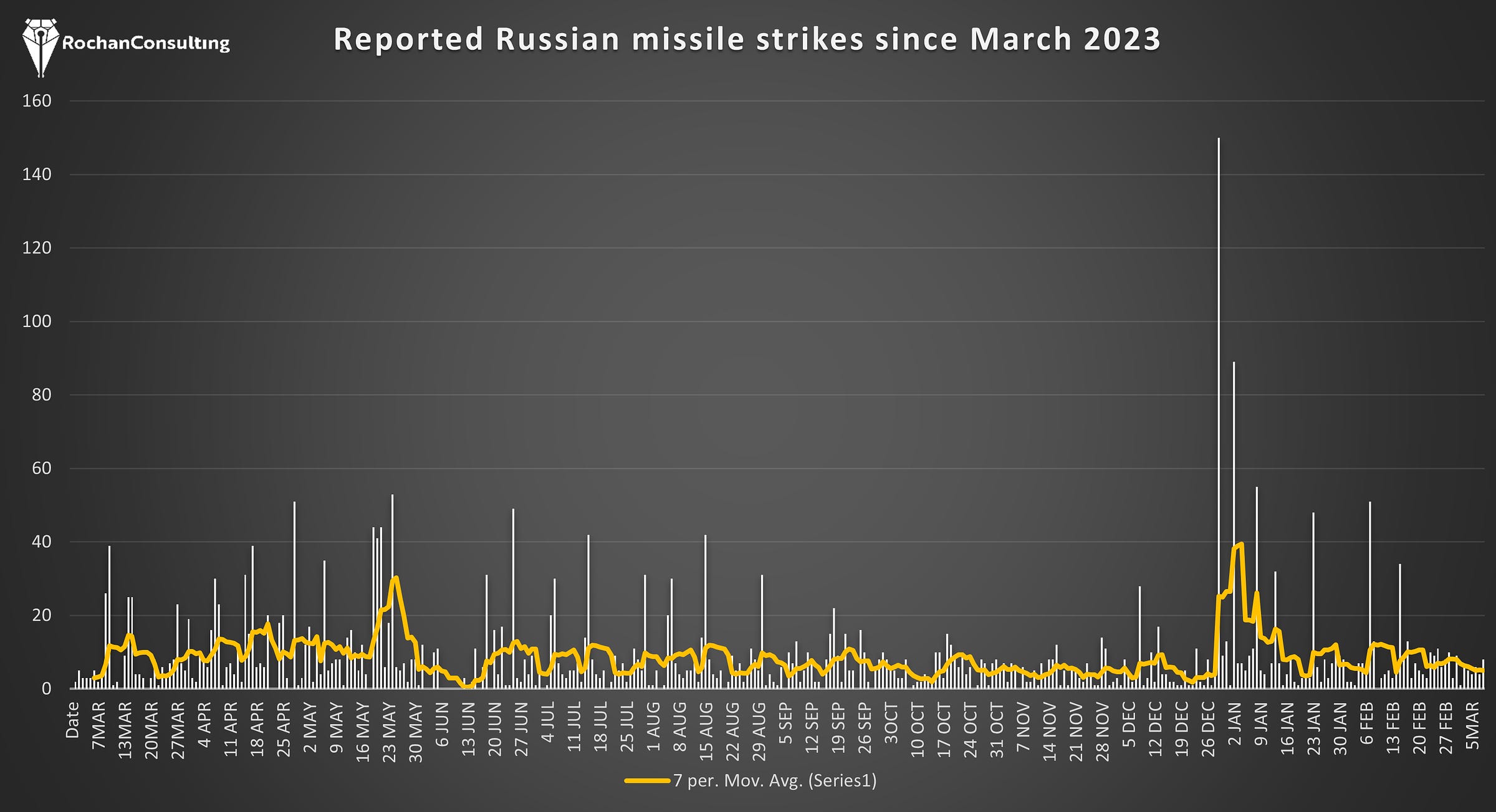
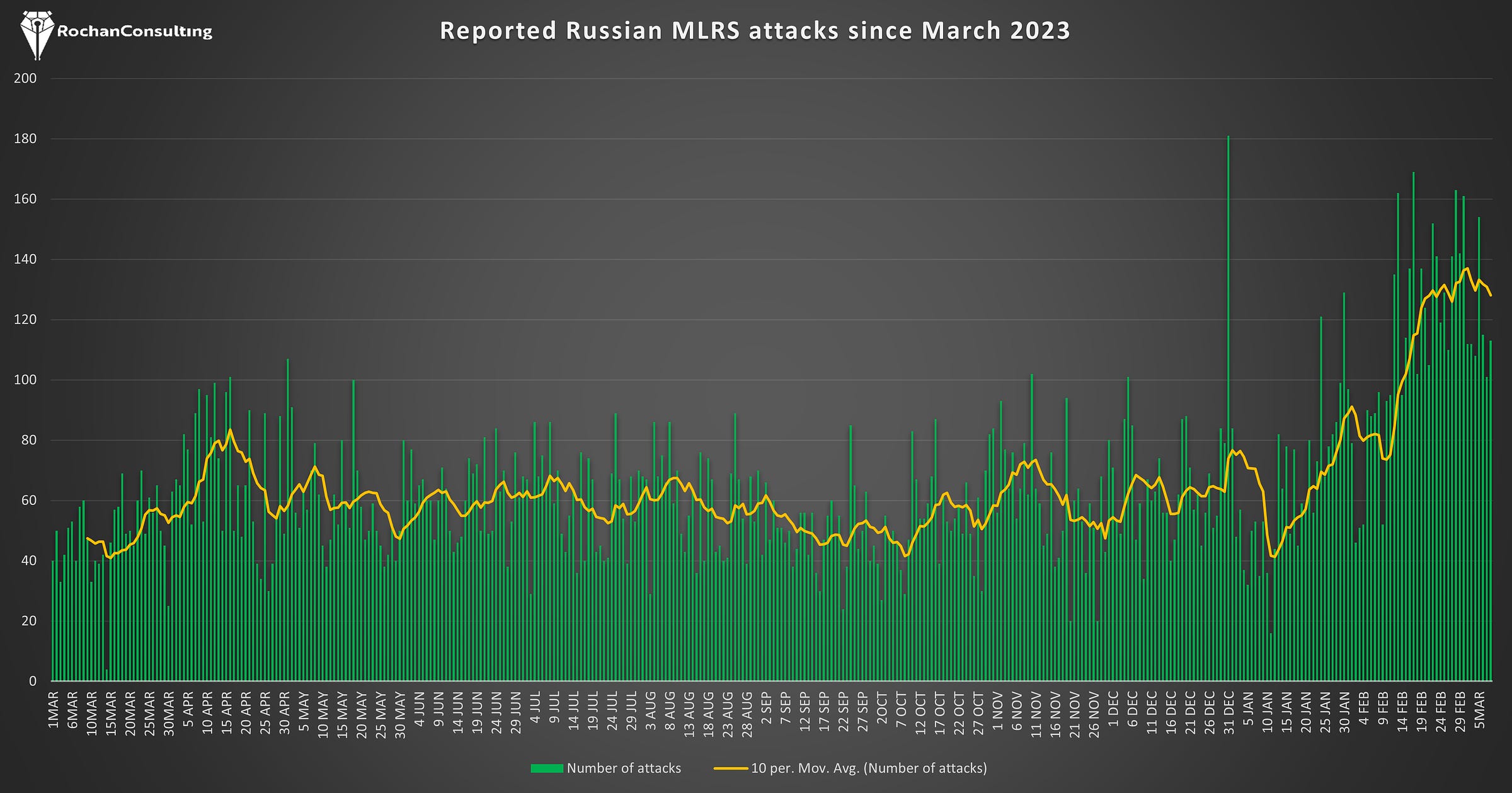
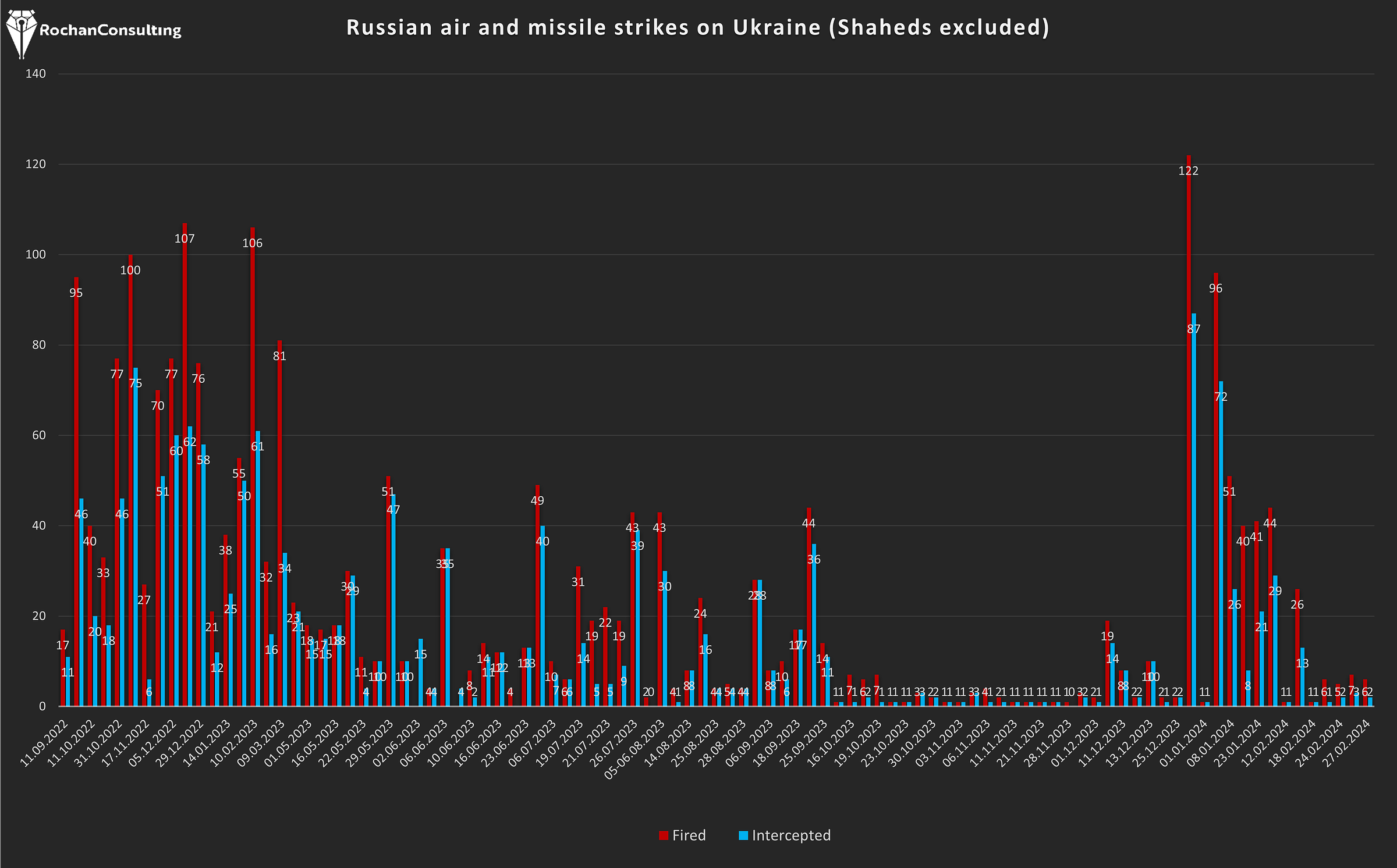
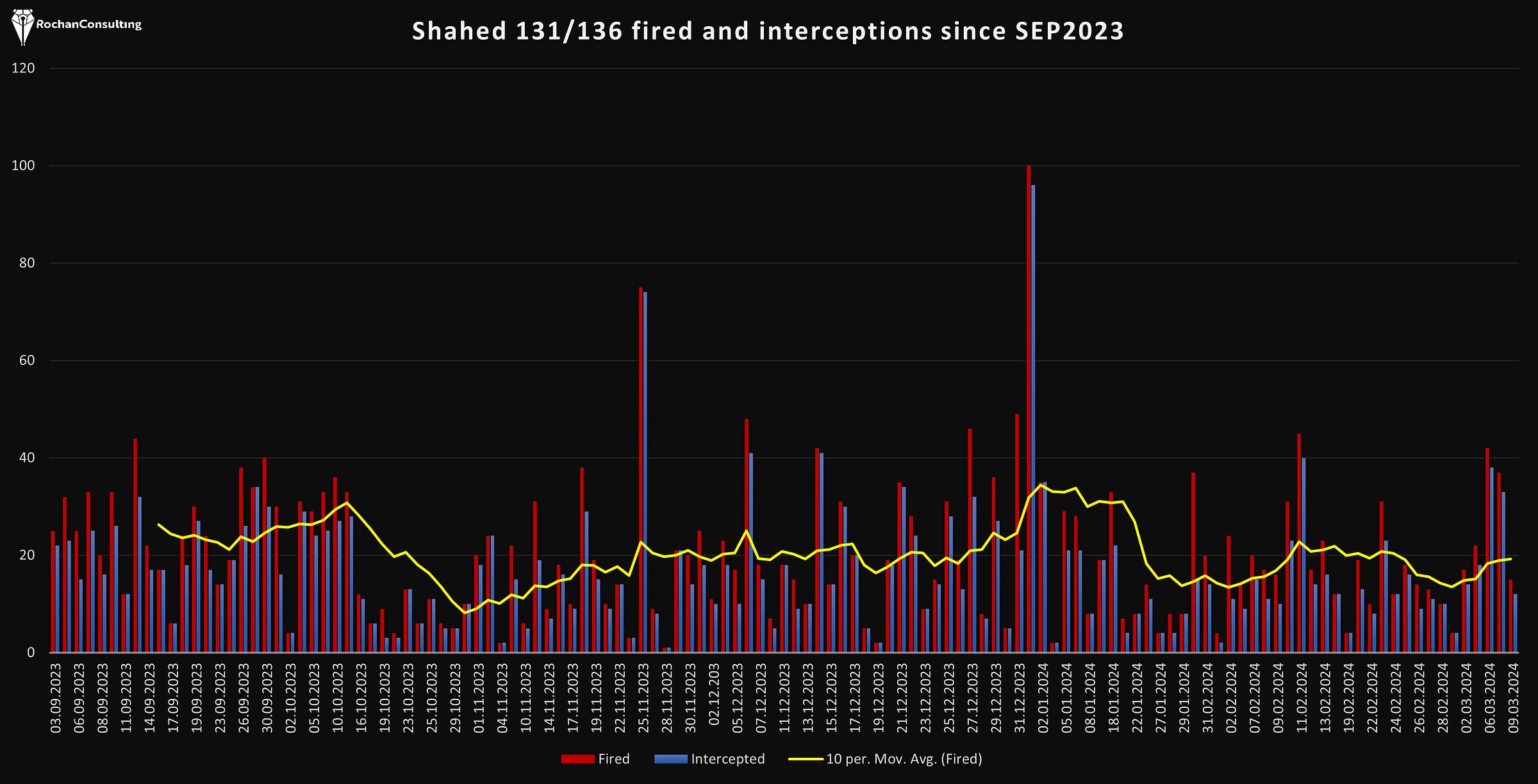
Outlook for the week of 09MAR024 – 15MAR2024
In assessing the probability or likelihood of certain events, we use a set of terms proposed by the US Intelligence Community.
To introduce more accountability to our forecasts, each weekly update assesses how correct (or incorrect) our predictions were. Please also remember that while we try to remain as objective as possible regarding our performance, the reader will ultimately have to decide how (in)accurate we have been.
Previous forecast
“Regarding the Kharkiv Oblast Direction, we continue to expect no frontline changes. There is a small possibility that Russians will conduct cross-border raids, but they will certainly continue (no change) conducting artillery attacks on civilian areas across the region. Russian cross-border infiltration operations are also certain to continue (no change).” This assessment was correct.
Score: 1/1
“When it comes to the Luhansk Oblast Direction, we maintain that Russian ground attacks in the Kupyansk and Lyman axes are highly likely (no change) to continue. It is unlikely (no change) that they will capture one village or more. We continue to expect no Ukrainian gains in the region.” Russians made marginal gains in the region but did not manage to capture a single settlement.
Score: 1/1
“When it comes to the Donetsk Oblast, we are still assessing that the probability of Ukrainian gains is remote (no change). We maintain that Russians are highly likely to capture some terrain (no change) in the Mariinka, Avdiivka and Bakhmut axes. There is roughly even chance (no change) that Russians will continue attacking west from the Avdiivka area to keep the momentum going.” Russians captured a couple of villages near Avdiivka over the past week, confirming our assessment that their attacks will be ongoing.
Score: 1/1
“Moving onto the Southern Direction, we currently assess that chances are remote (no change) that Ukrainians will make any gains in the region. We assess that Russians are likely (no change) to progress in the region (capture some terrain). Still, we assess they are unlikely to capture a village or more (no change).” This assessment was correct.
Score: 1/1
“In the Kherson Oblast, we assess that Ukrainians are unlikely (decrease in probability) to sustain a ground presence on Dnipro’s left bank. On the other hand, Russians are highly likely (no change) to sustain pressure on the Ukrainian bridgehead but are likely (increase in probability) to eliminate it completely”. We misjudged the Ukrainian determination to hold the bridgehead near Krynky and the Russian ability to push Ukrainians from the area.
Score: 0/1
Final Score: 4.0/5 (80%)
The forecast for the week of 09MAR024 – 15MAR2024
In parenthesis, we indicate a probability change compared to the previous assessment.
Regarding the Kharkiv Oblast Direction, we continue to expect no frontline changes. There is a small possibility that Russians will conduct cross-border raids, but they will certainly continue (no change) conducting artillery attacks on civilian areas across the region. Russian cross-border infiltration operations are also certain to continue (no change).
When it comes to the Luhansk Oblast Direction, we maintain that Russian ground attacks in the Kupyansk and Lyman axes are highly likely (no change) to continue. It is unlikely no change) that they will capture one village or more. We continue to expect no Ukrainian gains in the region.
When it comes to the Donetsk Oblast, we are still assessing that the probability of Ukrainian gains is remote (no change). We maintain that Russians are highly likely to capture some terrain (no change) in the Mariinka, Avdiivka and Bakhmut axes. It is highly likely (increase in probability) that Russians will continue attacking west from the Avdiivka, and there is a roughly even chance (new item) that they will capture one village or more.
Moving onto the Southern Direction, we currently assess that chances are remote (no change) that Ukrainians will make any gains in the region. We assess that Russians are likely (no change) to progress in the region (capture some terrain). Still, we assess they are unlikely to capture a village or more (no change).
In the Kherson Oblast, we assess that Ukrainians are likely (increase in probability) to sustain a ground presence on Dnipro’s left bank. On the other hand, Russians are highly likely (no change) to sustain pressure on the Ukrainian bridgehead but are unlikely (decrease in probability) to eliminate it completely.






